What does Rigveda contain?
Rigveda is the oldest sacred text that exists in the world. Mantras of Rigveda are used to invoke, praise, and make offerings to Gods during Yajnas. Learn here about the books of Rigveda, their origin, contents, purpose, how Rigveda is preserved and transmitted.
What does Rigveda contain?
Rigveda Samhita contains 10,552 hymns composed in meters called Chhandas.
They are called Riks, Richas, or Mantras.
They are mainly praises of Vedic Gods.
The following types of texts are also associated with Rigveda -
- Brahmanas
- Aranyakas
- Upanishads
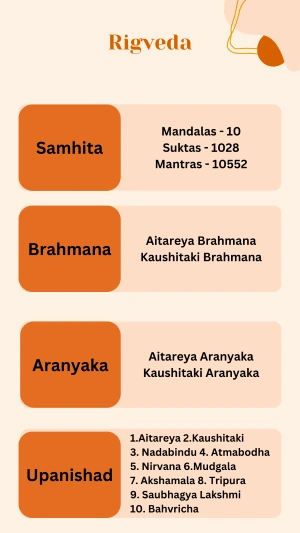
What is the use of Rigveda in Yajnas?
Mantras of Rigveda are used to invoke, praise, and make offerings to Gods during Yajnas. The priests of the four Vedas function together in the performance of the Yajnas. The Rigvedic priests in Yajnas are called Hotas.
When was Rigveda written?
Rigveda was neither written by any author or authors nor it was written at a particular time.
The Vedas are eternal.
They came into the possession of Brahma at the time of creation.
Brahma created the world with the power of the vibrations of the VedaMantras.
Later, these mantras were revealed to various Rishis.
Originally, the Vedas existed as a single corpus.
During DwaparaYuga, VedaVyasa compiled a collection of these mantras useful in performing Yajnas into four books.
They are Rigveda, Yajurveda, Samaveda, and Atharvaveda.
Scheme of classification
The Rigveda Samhita is classified using 2 schemes.
- Mandala - Sukta scheme - In this, the Samhita is divided into 10 Mandalas of uneven sizes. The Mandalas are subdivided into anuvakas, the anuvakas into suktas, and the suktas are made up of mantras or Riks.
- Ashtaka - Adhyaya scheme - In this, the Samhita is divided into 8 ashtakas. Each Ashtaka has 8 adhyayas. Each adhyaya has 8 vargas. Each varga has 5 verses. This scheme is more helpful in memorizing.
The Mandala - Sukta scheme is more popular.
| Mandala | Anuvaka | Sukta | Mantra | Deities | Rishis |
| 1 | 24 | 191 | 2006 | Agni, Indra, Varuna, Maruts, Rudra, Mitra ... |
Kanva, Angirasa, Vishwamitra, Vasishta, Kashyapa, Bharata
|
| 2 | 4 | 43 | 429 | Indra, Agni ... | Gritsamadas, Bhrigu |
| 3 | 5 | 62 | 617 | Agni, Indra, Vishwedevas ... | Vishwamitra, Angirasa, Bhrigu |
| 4 | 5 | 58 | 589 | Indra, Agni, Ushas, Brihaspati, Ashwins... | Angirasa |
| 5 | 6 | 87 | 727 | Indra, Agni, Vishwedevas, Maruts ... | Atri, Angirasa, Agastya, Vishwamitra, Vasishta |
| 6 | 6 | 75 | 765 | Indra, Agni, Ashwins, Pusha, Ushas ... | Angirasa |
| 7 | 6 | 104 | 841 | Indra, Agni, Vishwedevas, Maruts ... | Vasishta |
| 8 | 10 | 103 | 1716 | Various Devas | Kanva, Angirasa, Agastya, Atri, Kashyapa, Bhrigu |
| 9 | 7 | 114 | 1108 | Soma Pavamana | Kanva, Angirasa, Agastya, Vishwamitra, Atri, Vasishta, Kashyapa, Bharata, Bhrigu |
| 10 | 12 | 191 | 1754 | Agni and various Devas | Kanva, Angirasa, Agastya, Vishwamitra, Atri, Vasishta, Kashyapa, Bharata, Bhrigu |
| Total | 85 | 1028 | 10552 |
Recensions of Rigveda
Several Rigvedic schools came into existence through which Rigveda was preserved and transmitted.
They are called Shakhas, each with its own recension of Rigveda.
Patanjali mentions 21 such recensions.
According to CharanaVyuha, 5 recensions are prominent -
- Shakala
- Bashkala
- Ashwalayana
- Sankhyayana
- Mandukayana
Among these, Bashkala existed till the 16th century.
Only Shakala is available now.
These schools not only preserved and transmitted the Vedas but also tried to interpret their meaning.
Topics of Rigveda Samhita
Topic 1 - Praises
These Riks describe the characteristics and supernatural powers of Devas such as Indra, Agni, and Varuna. They are useful in Yajnas and Sagunopasana. They are expected to induce the Devas to grant favors. Many of the glorious deeds of the Devas are recounted. Referring to their past deeds, the mantras call upon the Devas to replicate them in the present and bless their worshipers. The praises seek wealth, long life, progeny, aid in defeating enemies. A large part of Rigveda is dedicated to the conduct of SomaYagas.
Topic 2 - Philosophy
- Origin of the universe
- True nature of man
- Omnipresence, omnipotence, and omniscience of God.
- Monotheism.
Topic 3
Marriage, warfare, social order, etc.
Rigveda Brahmanas
Brahmana texts provide detailed procedures and principles behind Yajnas. They belong to the KarmaKanda of the Vedic corpus.
- Aitareya Brahmana - Mahida Aitareya is the author of this text. It deals with the procedures of SomaYaga, Rajasuya, etc. It is also known as Ashwalayna Brahmana. There are 40 chapters divided into 8 Panchakas.
- Kaushitaki Brahmana - This is also known as Sankhyayana Brahmana. There are 30 chapters in this.
Rigveda Aranyakas
They discuss the mystical and philosophical aspects of Yajna. Aranyakas are the UpasanaKanda of the Vedas.
- Aitareya Aranyaka - There are five books each one divided into adhyayas. Each adhyaya is further subdivided into khandas. The main topics discussed are -
- Explanation of Mahavrata
- Importance of speech in humans
- Creative power of the Supreme Being
- Importance of Prana
- Mystical meanings of the Rigveda Samhita mantras
- Meaning of Mahanamni hymns
- Kaushitaki Aranyaka - There are 15 adhyayas in this and contains -
- Ritualistic explanation of Mahavrata
- Explanation of Aitareya Aranyaka
Rigveda Upanishads
Upanishads are secrets taught by established teachers to committed and deserving students.
They are the essence of the Vedic corpus and are called the JnanaKanda.
Upanishads are the culmination of Vedic thought.
The ten Upanishads connected to Rigveda are -
- Aitareya Upanishad
- Kaushitaki Upanishad
- Nadabindu Upanishad
- Atmabodha Upanishad
- Nirvana Upanishad
- Mudgala Upanishad
- Akshamala Upanishad
- Tripura Upanishad
- Saubhagya Lakshmi Upanishad
- Bahvrichi Upanishad
What are the Rigvedic priests in Yajnas called?
Hotas.
Which is the only existing shakha of Rigveda?
Shakala.
Quiz
Are all Rishis male?Recommended for you
Mantra For Blessings Of Lord Subrahmanya
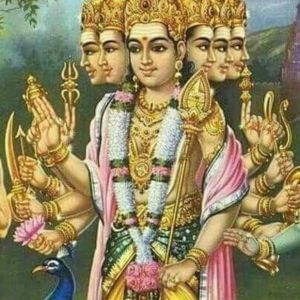
कार्त्तिकेयाय विद्महे सुब्रह्मण्याय धीमहि तन्नः स्कन्�....
Click here to know more..Rama Mantra For Getting A Good Spouse
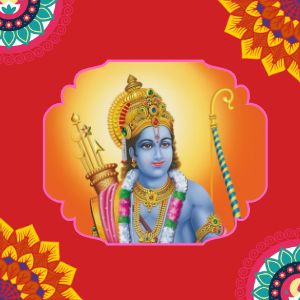
दाशरथाय विद्महे सीतावल्लभाय धीमहि । तन्नो रामः प्रचोदय....
Click here to know more..Surya Graha Stotram
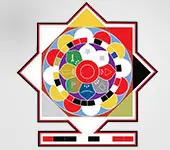
ग्रहाणामादिरादित्यो लोकरक्षणकारकः। विषणस्थानसंभूतां ....
Click here to know more..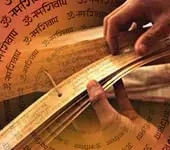
English Topics
Vedas
Click on any topic to open
- 85 Culture vis-a-vis Agriculture
- 84 Whenever I have Read any Part of the Vedas
- 83 Vedas - Holy Books Of Hinduism
- 82 How The Vedas Manifested Into Material Objects
- 81 What does Rigveda contain?
- 80 Why Vedas are called Shruti?
- 79 What Vedas say about periods
- 78 How Vedas Came Into Existence
- 77 Vedas are eternal, not written by anyone
- 76 Relationship Between The Vedas And The World
Please wait while the audio list loads..
30
Ganapathy
Shiva
Hanuman
Devi
Vishnu Sahasranama
Mahabharatam
Practical Wisdom
Yoga Vasishta
Vedas
Rituals
Rare Topics
Devi Mahatmyam
Glory of Venkatesha
Shani Mahatmya
Story of Sri Yantra
Rudram Explained
Atharva Sheersha
Sri Suktam
Kathopanishad
Ramayana
Mystique
Mantra Shastra
Bharat Matha
Bhagavatam
Astrology
Temples
Spiritual books
Purana Stories
Festivals
Sages and Saints
